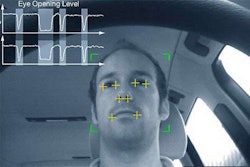Until very recently, the Federal Motor Carrier Safety Administration has largely ignored fatigue monitoring technology, and therefore any potential it has for a significant revision of the hours of service.
Instead, regulators for decades have tinkered with the hours of service as if it were a magic template to solve the fatigue problem for every individual in every trucking application. Anyone familiar with trucking’s diverse operations and their infinite disrupters knows this to be a pipe dream.
 SmartDrive recently announced its SmartSense system, which uses data from two cameras, the engine computer and other sources to identify driver distraction and fatigue.
SmartDrive recently announced its SmartSense system, which uses data from two cameras, the engine computer and other sources to identify driver distraction and fatigue.In the meantime, fleets, motivated by good results and potentially lower insurance premiums, are beginning to integrate fatigue monitoring tech, as our “Fatigue’s fast track” series has reported. Most notably, they’re adopting road-facing dashcams, which can be used for monitoring fatigue. Now some dashcam vendors are pushing driver-facing cams that are increasingly able to detect potential fatigue or distraction. Other monitoring tech, having succeeded in other industries, is also beginning to penetrate trucking.
For owner-operators, this is a mixed bag:
- Driver-facing cams are abhorrent to many drivers, for obvious reasons. Even if eventual legal challenges over privacy issues raised by use of the cams fail, some fleet owners will respect drivers enough to avoid the practice anyway. After all, a fleet owner who wants to monitor for fatigue can choose other technologies. As for the fleets that insist on the cams, they will notice if enough drivers choose to work for fleets that don’t.
- Other than road-facing cams, relatively limited in their fatigue detection capabilities, most non-camera systems involve a wearable device. That, too, is considered by some to be a personal intrusion. Does the benefit outweigh that concern? Many would say yes. Fatigue is widely considered to be a direct or contributing cause for thousands of highway deaths annually.
- It’s hard to fathom the managerial chaos that could result from abandoning a clock-based HOS and instead relying on technology that rules whether any driver is fit to start driving or continue driving. Likely it would require a very gradual integration of fatigue monitoring. From a driver perspective, less subjugation to a highly flawed HOS, and therefore also to electronic logging devices, could be a big bright spot.
- As fleets try out monitoring systems, certain ones and certain combinations of them with other data streams will prove to work better than others. FMCSA would have to weigh this experience, as well as continue its own testing, before even proposing a radical HOS change. Many of today’s drivers will be retired or enjoying an eternal subterranean 10-hour break before that day comes, but it is coming.
SmartDrive recently announced its SmartSense system, which uses data from two cameras, the engine computer and other sources to identify driver distraction and fatigue.










